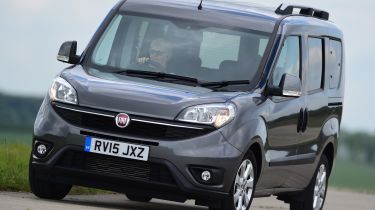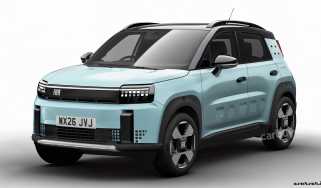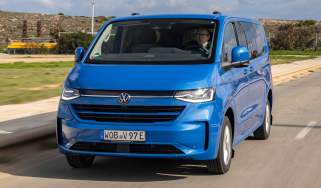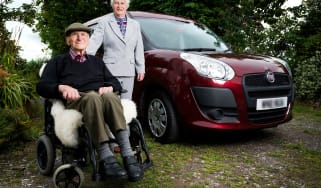Fiat Doblo MPV review (2010-2021)
"The van-based Fiat Doblo is good for families who need lots of space for less money than a traditional MPV"
Pros
- Economical engines
- Good value for money
- Hugely practical
Cons
- Boxy styling
- Uninspiring build quality
- Diesels are noisy around town
Those seeking space and practicality at an affordable price should be drawn to a van-based MPV like the Fiat Doblo. Officially known as the Doblo Passenger, it’s based on the Doblo van (and is sold through Fiat Professional showrooms), so its boxy lines mean there's lots of space inside. The optional upgrade to seven seats doesn’t cut cabin space too severely, while turning the Doblo into a roomy people carrier.
We’re glad to see that a touchscreen with Apple CarPlay and Android Auto is now standard. The base model isn’t particularly generous, with twin sliding doors, hill-hold assist and a speed limiter being the highlights. Upgrading to Tecnico spec will make the Doblo feel less like a commercial vehicle, with air conditioning, cruise control, a height-adjustable driver’s seat and parking sensors. A Trekking version brings off-road looks and raised ground clearance.
A 1.6-litre Multijet diesel is fitted in every new Doblo, with a choice of 89bhp, 104bhp and 118bhp. Performance is, unsurprisingly, not a priority, with the lowest-powered option taking around 14 seconds to get from 0-62mph and having a top speed of 98mph. Fuel efficiency is still not great when compared with rivals. A 94bhp 1.4-litre petrol engine was previously available.
The Fiat Doblo is now over a decade old and feels it compared to newer rivals like the Peugeot Rifter and Volkswagen Caddy. It’s surprisingly expensive too, so the Doblo is hard to recommend.
MPG, running costs & CO2
Prices look competitive until you realise they’re listed before VAT. Factor it in and a base-spec Doblo becomes around £2,000 more expensive than the cheapest Ford Tourneo Connect and Citroen Berlingo.
Economy and emissions aren’t class-leading but they aren’t catastrophic either. Each of the three diesel engines will manage around 45mpg, with long-wheelbase Maxi and raised-height XL versions ever so slightly less efficient. CO2 emissions of 159-173g/km are high. Every Doblo costs the standard rate in annual road tax.
Engines, drive & performance
The engine line-up includes 89bhp, 104bhp and 118bhp 1.6-litre Multijet diesels, although a 1.4-litre petrol engine was offered and is fine if your journeys tend to be around town. The diesels don’t feel particularly slow because their maximum power comes in quite low down in the rev range, even though their quoted 0-62mph times are slow on paper. The larger diesel is well suited to motorway use.
Despite the Doblo’s van roots, it corners well. The steering is precise, handling is sharp, grip is good and body roll less pronounced than in the previous car. A huge front windscreen ensures there’s excellent visibility.
Interior & comfort
Soft springs mean the Doblo soaks up bumps in the road easily, while the cabin doesn’t suffer from wind noise on the motorway. There’s plenty of head and legroom inside, even if you upgrade to seven seats, and the seats themselves are soft and comfortable. It sounds like a perfect combination but overall the Doblo is simply getting on a bit now and is outclassed by its rivals that feel much more modern.
At least the car now features a touchscreen media system as standard, rather than a simple radio. It gives you Bluetooth phone connectivity and digital radio, plus Apple and Android phone mirroring. Upgrading to Tecnico will cost extra but it feels less sparse; air conditioning, rear sensors, cruise control and other niceties make it feel more like a car than a van.
Practicality & boot space
It’s hard to top the Doblo for practicality. The boot boasts a strong 790-litre capacity; remove the seats and that rises to an enormous 3,200 litres. The sturdy parcel shelf is capable of supporting up to 70kg, while sliding rear doors make access easy. Fiat offers a Family Pack option that adds two more seats to turn the Doblo into one of the cheapest seven-seaters on the market.
Reliability & safety
Fiat cars haven’t always had the strongest record for reliability, and the brand actually finished in last place for overall owner satisfaction in our 2016 Driver Power survey. The Italian company was the worst placed out of 32 brands covered, with owners particularly disappointed by the comfort and ride quality of their cars. Quality wasn’t rated highly and owners weren’t impressed by reliability, either. Fast-forward to 2021 and the brand has only moved to 26th place out of 29.
On the plus side, for running costs the brand was ranked in a strong 11th place. These ratings are based on the overall results from all Fiat owners who took part in the survey – we should stress that too few Doblo owners responded for the model to have been individually assessed.
It’s less easy to be positive when it comes to the Doblo’s safety, though. When it was tested by independent crash safety experts Euro NCAP in 2017, it received a rather mediocre three-star rating. Protection for adult occupants was rated at 75%, while children would likely fare worse, with their protection rated at 46%. The way the Doblo’s seatbelts and airbags protected the car’s occupants in a crash came in for some criticism in the organisation’s report and it was noted that no autonomous emergency braking system is available.


















